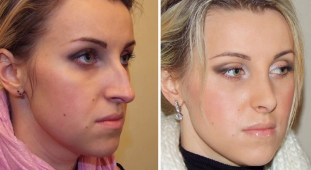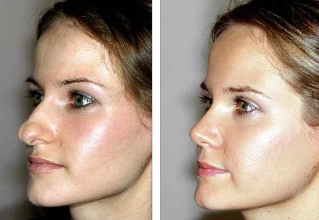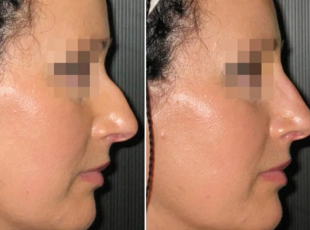Rhinoplasty, one of the most popular plastic surgeries that involve manipulation of the nose. The objective of this procedure to restore the proper shape of the nose, which was as a result broken of the injury, or disease, congenital anomalies.
The history of the development

You may think that the invention of a rhinoplasty and recent, and to use the services of surgeons completely the sun, stars and models. This does not offer as well. The first mention of the technique of recovery of the nose to the back as antiquity. Similar operations were carried out a t for every 1000 india India male BC years had partially damage noses", taking the skin of the cheek of the patient.
In Europe, the rhinoplasty that was developed in the Middle ages. Italian surgeons are descriu his own method of recreating the shape of the nose from the skin of the face. In the early 19th century, this type of operation s has received from the un new impetus, thanks to the efforts of the English and German doctors. There are new methods, based on the experience of Indian surgeons.
Initially, the goal of the rhinoplasty is that your going to repair the nose, aesthetic & aesthetic factors have gained importance at the end of the 20th century.
Medical indications for rhinoplasty
Plastic surgery Anyone can be so un creative process, and the rhinoplasty there is no n exception. It combines the solution of a problem with the aesthetic or preservation of the restoration of the functions of the authority (is the nasal breathing).
Thus, intervention to follow this pot both therapeutic and cosmetic purposes. Best to do the surgery at the age of 25-30 years, when it is completely the cartilage formed. Of course, the recommended age pot to a change in function of the particular circumstances.
Medical indications:
- Violation of nasal breathing, or the complete lack of this.
- Carpal that have lead to a deformation of the changes and the cartilage and bones.
- Physiological and compensatory deviations of the nasal septum.
- Congenital curvature or deformity of the nasal septum.
- Cysts and polyps in the nose.
- Hypertrophy of the turbinates.
Alterations in the structure of the anatomical of the nose lead to different functional complications and pathological conditions. This can include: otitis media, rhinosinusitis, asthma, snoring, frequent respiratory infections, atrophy or hypertrophy of the membranes of the nose, difficulty in nasal breathing.
Especially dangerous violation nasal breathing for children. Can cause oxygen starvation of the brain, which leads to physical and mental development delays. L ' operation to restore the function can be assigned to respiratory disease in 18 years.
Cosmetic indications for rhinoplasty
More than half of the operations change the shape of the nose done for cosmetic reasons. The patients want to achieve harmony in your appearance. Aesthetic indications for plastic surgery can be divided into two subgroups:
- Goal. When the nose and disproportionate in size, shape.
- Subjective. The subgroup includes This one, above all, psychological reasons related to the assessment of his appearance. For example, the patient as a small eps, or upturned.
Psychological Causes are often associated with professional or social environment. Patient complex The has, a profound dissatisfaction with their appearance.
Aesthetic indications:
- The deviation of the septum.
- Acquired and congenital deformities.
- Disproportionate size relative to the face the nose when it seemed too much too big or small.
- Saddle nose shape.
- Bump.
- Nose Too big.
- Little attractive form when the tip of the nose forked, lowered, raised, thick, or aim.
- Asymmetric nose.
- Correction of the consequences of a failed rhinoplasty.
And important to understand that the result of the operation is not always possible to get un perfect result. In surgery, there are limitations, therefore, of the rhinoplasty's must be seen as a correction of an existing form.
Contraindications

Before the surgery, many patients are advised to see a psychologist at the un. There are cases in which the patient has a normal, shape of the nose sense the aesthetic or functional disorders. Then, the problem resolved and original works of art will be working with the psychologist.
Plastic surgeons can produce special measures, I mean exactly if there are any defects. There are certain parameters to evaluate the shape of the com the nose and the harmony of its relative position to the forehead, the eyes, the mouth, chin, ears. With the advice of a doctor, you can simulate on the computer the supposed appearance original work of art from the surgery.
Contraindications:
- No age limit. The surgery is not recommended and before of 18 and original works of art of 40 years. These limitations may be removed due to causes goals.
- Diabetes, the kidneys, the liver, the cardiovascular system.
- Folliculitis and acne in the area of the nose.
- The coagulation of the blood.
- Oncology.
- Mental illness.
- The period of menstruation.
Types of rhinoplasty
In terms of the objectives and techniques of performing the surgery that is rhinoplasty divided into several types.
Goals for rhinoplasty may be:
- Reconstructive. This recovery of the offences, which occurred due to diseases, injuries, defects and fetal development.
- Aesthetic. This a and correction of aesthetic defects.
During the operation can be carried out
- Increase or decrease of the nose.
- The removal of the hump.
- Correction of saddle nose shapes, and a say, the elimination of the recreation.
- Correction of the shape of the tip of the nose.
- Septoplastike (this, correction of the nasal septum).
- Post-traumatic reconstruction.
According to the method of access to the surgery can be closed and open. Private method used in aesthetic operations, since less and traumatic. In this case, the incisions are all made inside the nasal cavity. The skin is separated from cartilage and the surgeon can adjust the way of working with bone cartilage and tissue, to remove excess or increase with implants. Original works of art to manipulate the detail, well presented and very.
Open rhinoplasty's used in difficult cases to correct severe changes, and execute large-volume transactions. The cut is made in the skin crease between the beers of the nose. In this case, the surgeon gains access to the tissues, cartilages and bones. Healing with this method requires more time, still, a noticeable postoperative scar.
Non-surgical rhinoplasty
Non-surgical rhinoplasty towards an alternative to the surgical intervention. However, there are methods to correct small defects.
Rhinoplasty with fillers (cosmetic gel) will help to correct small defects, smooth out sharp angles, restoring symmetry, a change of the shape of the tip. The use the fillers to conceal allows un small bump, to remove the hollowness, in the round of the tip.
The recovery period of the surgery original works of art and more easy the low price, wi-fi, in comparison with an operation to full-fledged. However, the effect of the loads will continue for only a few short months (maximum 1.5 any). In some cases, the injection is formed fibrous tissue, and the external effect of the procedure jade many years. But often requires the procedure of a second. There is a complication: migration of the introduced gel and a change in the structure of the fabric of repeated injections original work of art.
With the help of injections not only increase, but also to remove the tissue. There are un-prepared hormonal base, that can eliminate cops, bulges and even in some cases, the hump. With the introduction of these drugs and very important to take care. Often the procedure is done in destinations of phases. Original works of art from 2-3 weeks there will be un-significant result.
With the help of special threads you can adjust the shape of the beer of the nose, and even lifting of the tip. Set of thread through it to form pinholes pot scars. You can break It due to the mobility of the nose. For these reasons, the surgeons go a few times this procedure.

Preparation for surgery
Successful For a transaction requires the collaboration of the patient and the doctor. Before the intervention of the consultation, in the patient-surgeon told to get the desired result.
Carried out studies of a General nature: the blood count, coagulation study, d', urinalysis, ELECTROCARDIOGRAM, test of HIV, hepatitis, syphilis.
And If necessary, will the un special study, and l'. If you have a chronic illness, you need to consult a gp or specialist relevant. The intervention will be postponed in case of aggravation of chronic diseases, the emergence of serious respiratory diseases or infectious lesions of the skin. Prior to surgery you will meet with the anesthesiologist.
Your doctor may recommend refraining from alcohol, Smoking, eliminate junk food, stop taking sleeping pills and sedatives. Two weeks prior to the intervention of a necessary to stop taking aspirin and its analogues.
Complications
Rhinoplasty, one of the most complex plastic surgery as an important aesthetic and functional side. Case of complications in function of various factors 4-15 in% of patients. They can be divided into operation and aftercare.
Operative complications:
- bleeding;
- breaks in the skin;
- the violation of the integrity of the bones or fractures;
- separation cartilage of the flap, etc.
Postoperative complications:
- the loss of the sense of smell;
- the loss or decrease of the sensitivity of the nose and the lower lip;
- obstruction of nasal breathing;
- rhinitis atrophic;
- impairment correct un defect aesthetic or lack of changes;
- psychological complications (patient does not accept changes in the appearance, he doesn't like the new face);
- swelling of the nose and eyelids, inflammation, suppuration;
- pigmentation of the skin of the scar in the formacio of the same capillary;
- frequent or prolonged nosebleeds;
- necrosis.
The most dangerous complication that can occur during the rhinoplasty and an allergic reaction to the anesthesia. Anaphylactic shock can cause death in 20% of cases.
The recovery period
The patient can leave the hospital within a few hours of the image original surgery or over night for observation. The main recovery of the repair work of original art of the nose has a duration of 3 weeks. Full restoration will come in the original work of art only six months or a year.
The seams and plaster Longuet will be removed in ca 1.5 weeks. Another 2 weeks will not be able to take a hot shower, wash your face with hot water – which can cause bleeding, bruising, swelling of the face and neck. Need to sleep on your back supported. You can't bend, lift weights. Environments En from dust and areas must wear a mask.
In the period of three months should be completely protected from Hell and the pressure on the nose, not to wear any glasses, masks, hard hats. It is prohibit the use of the pool and take the sun. The surgeon may also impose restrictions, dictated by the individual condition of the patient.
The results of the operation
The healing of cartilage and bone tissue jade a few months. The end result, and the surgeon I will be the patient able to evaluate original works of art d d about 8 months. The decision to do a rhinoplasty (especially if you do not have absolutely clear testimony), which can be perceived negatively and, therefore, the patient should be prepared for mixed reactions from family and friends.
Family members can be content with the loss of the ethnic family is. However, often the patient and his family, I did not notice much effect an operation d, because the inflammation's hidden changes appear a little a little.
Rhinoplasty and quite capable to change the look, but do not assume that the use of the plastic surgery sense restrictions and possible a model for all present in the fantasy. Any type of surgery, and a dangerous thing, can lead to complications, and even the worsening deficiency of the. Therefore, to treat this type of intervention has to be seriously, carefully assessing the potential benefits and the risk of negative consequences.




















